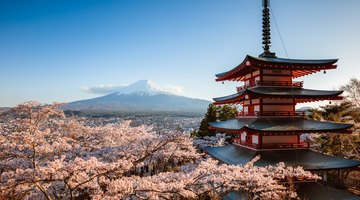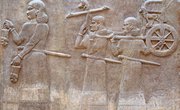During Japan's Age of Warring States, the country was without any effective central government from about 1467 to 1603. Buddhist temples, peasant rebels and samurai clans led by regional warlords all fought each other for power. Christian missionaries made many converts in the chaos of this era, but when the Tokugawa clan finally reunified the nation it decided to crush Christianity in Japan by expelling all foreigners.
Warring States, Warring Faiths
In medieval Japan, important Buddhist temples of the Tendai and Shingon sects maintained large armies of warrior monks and used them in the wars between samurai lords and the imperial government. When the Onin War of 1467-1477 caused central government to collapse and brought in the Age of Warring States, the warrior monks were joined by armies of peasant rebels known as "ikki", fervent believers in a militant form of Buddhism. The samurai warlord Oda Nobunaga initially welcomed Christian missionaries to weaken the military power of the Buddhist sects. His successor Toyotomi Hideyoshi became concerned that Christianity could be a front for European colonialism and began to persecute Christians in 1597.
Stability Through Seclusion
After the death of Toyotomi Hideyoshi, the Tokugawa clan came to power and ended the Age of Warring States in the year 1603 by reunifying Japan under the first Tokugawa "shogun" or dictator, Tokugawa Ieyasu. The one priority of the Tokugawa was to restore the peace and stability of Japan after more than a century of civil war. The Tokugawa shared Hideyoshi's suspicions that Christian missionary work could be a pretext for a future invasion of Japan by one of the European powers. In 1635, shogun Tokugawa Iemitsu decided that the only way to ensure Japan's stability and independence was to cut off almost all contact with other nations.
The Isolation Edict
In the isolation edict of 1635, the shogun banned Japanese ships or individuals from visiting other countries, decreed that any Japanese person returning from another country was to be executed, and placed severe restrictions on visits by foreign trading vessels. Christian missionary activity was outlawed, Christianity was banned in Japan and large rewards were offered for anyone who turned in a suspected Christian. The persecution of Christians and the harsh treatment of peasants led to the Shimabara rebellion just two years later.
The Shimabara Rebellion
The Shimabara rebellion was a major uprising of Christian peasants and their sympathizers, aided by samurai from clans that had lost power with the rise of the Tokugawa. The similarity between a peasant rebellion inspired by Christianity and the "ikki" uprisings of Buddhist peasants during the Warring States era was not lost on the Tokugawa shoguns. The Tokugawa were determined to prevent both foreign colonization and a return to domestic instability, and they had no intention of allowing a new militant Christianity to take the place of the militant Buddhism Nobunaga had finally suppressed. After the defeat of the Shimabara rebels, Tokugawa Iemitsu issued his second seclusion edict in 1639, banning all Portugese merchants from entering the country and initiating two centuries of almost complete isolation.
Related Articles
References
Writer Bio
Scott Thompson has been writing professionally since 1990, beginning with the "Pequawket Valley News." He is the author of nine published books on topics such as history, martial arts, poetry and fantasy fiction. His work has also appeared in "Talebones" magazine and the "Strange Pleasures" anthology.










